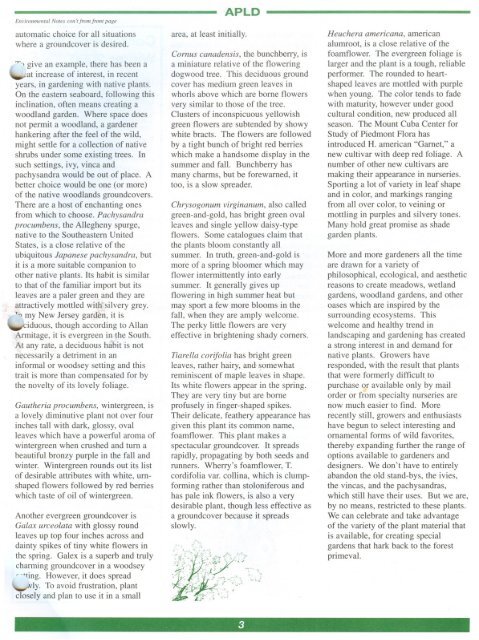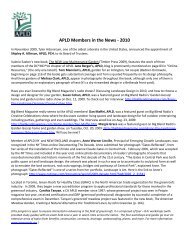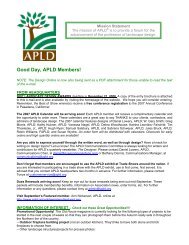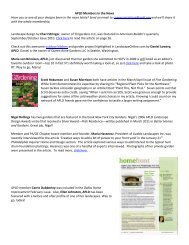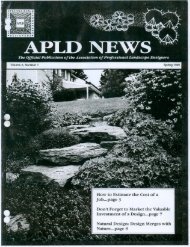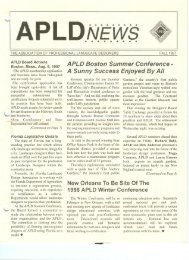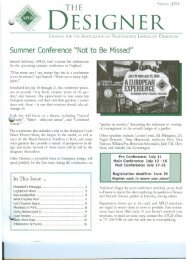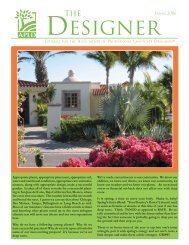Confer~nce 1999 - Association of Professional Landscape Designers
Confer~nce 1999 - Association of Professional Landscape Designers
Confer~nce 1999 - Association of Professional Landscape Designers
Create successful ePaper yourself
Turn your PDF publications into a flip-book with our unique Google optimized e-Paper software.
Environmental Notes con 'tfrom front page<br />
automatic choice for all situations<br />
where a ground cover is desired.<br />
..,.,,,give an example, there has been a<br />
'at increase <strong>of</strong> interest, in recent<br />
years, in gardening with native plants.<br />
On the eastern seaboard, following this<br />
inclination, <strong>of</strong>ten means creating a<br />
woodland garden. Where space does<br />
not permit a woodland, a gardener<br />
hankering after the feel <strong>of</strong> the wild,<br />
might settle for a collection <strong>of</strong> native<br />
shrubs under some existing trees. In<br />
such settings, ivy, vinca and<br />
pachysandra would be out <strong>of</strong> place. A<br />
better choice would be one (or more)<br />
<strong>of</strong> the native woodlands groundcovers.<br />
There are a host <strong>of</strong> enchanting ones<br />
from which to choose. Pachysandra<br />
procumbens, the Allegheny spurge,<br />
native to the Southeastern United<br />
States, is a close relative <strong>of</strong> the<br />
ubiquitous Japanese pachysandra, but<br />
it is a more suitable companion to<br />
other native plants. Its habit is similar<br />
to that <strong>of</strong> the familiar import but its<br />
leaves are a paler green and they are<br />
attractively mottled with silvery grey.<br />
T., my New Jersey garden, it is<br />
ciduous, though according to Allan<br />
Armitage, it is evergreen in the South.<br />
At any rate, a deciduous habit is not<br />
necessarily a detriment in an<br />
informal or woodsey setting and this<br />
trait is more than compensated for by<br />
the novelty <strong>of</strong> its lovely foliage.<br />
Gautheria procumbens, wintergreen, is<br />
a lovely diminutive plant not over four<br />
inches tall with dark, glossy, oval<br />
leaves which have a powerful aroma <strong>of</strong><br />
wintergreen when crushed and turn a<br />
beautiful bronzy purple in the fall and<br />
winter. Wintergreen rounds out its list<br />
<strong>of</strong> desirable attributes with white, urnshaped<br />
flowers followed by red berries<br />
which taste <strong>of</strong> oil <strong>of</strong> wintergreen.<br />
Another evergreen groundcover is<br />
Galax urceolata with glossy round<br />
leaves up top four inches across and<br />
dainty spikes <strong>of</strong> tiny white flowers in<br />
the spring. Galex is a superb and truly<br />
charming groundcover in a woodsey<br />
r -"~ing. However, it does spread<br />
Nly. To avoid frustration, plant<br />
closely and plan to use it in a small<br />
APLD<br />
area, at least initially.<br />
Comus canadensis, the bunchberry, is<br />
a miniature relative <strong>of</strong> the flowering<br />
dogwood tree. This deciduous ground<br />
cover has medium green leaves in<br />
whorls above which are borne flowers<br />
very similar to those <strong>of</strong> the tree.<br />
Clusters <strong>of</strong> inconspicuous yellowish<br />
green flowers are subtended by showy<br />
white bracts. The flowers are followed<br />
by a tight bunch <strong>of</strong> bright red berries<br />
which make a handsome display in the<br />
summer and fall. Bunchberry has<br />
many charms, but be forewarned, it<br />
too, is a slow spreader.<br />
Chrysogonum virginanum, also called<br />
green-and-gold, has bright green oval<br />
leaves and single yellow daisy-type<br />
flowers. Some catalogues claim that<br />
the plants bloom constantly all<br />
summer. In truth, green-and-gold is<br />
more <strong>of</strong> a spring bloomer which may<br />
flower intermittently into early<br />
summer. It generally gives up<br />
flowering in high summer heat but<br />
may sport a few more blooms in the<br />
fall, when they are amply welcome.<br />
The perky little flowers are very<br />
effective in brightening shady corners.<br />
Tiarella corifolia has bright green<br />
leaves, rather hairy, and somewhat<br />
reminiscent <strong>of</strong> maple leaves in shape.<br />
Its white flowers appear in the spring.<br />
They are very tiny but are borne<br />
pr<strong>of</strong>usely in finger-shaped spikes.<br />
Their delicate, feathery appearance has<br />
given this plant its common name,<br />
foamflower. This plant makes a<br />
spectacular groundcover. It spreads<br />
rapidly, propagating by both seeds and<br />
runners. Wherry's foamflower, T.<br />
cordifolia var. collina, which is clumpforming<br />
rather than stoloniferous and<br />
has pale ink flowers, is also a very<br />
desirable plant, though less effective as<br />
a groundcover because it spreads<br />
slowly.<br />
Heuchera americana, american<br />
alumroot, is a close relative <strong>of</strong> the<br />
foamflower. The evergreen foliage is<br />
larger and the plant is a tough, reliable<br />
performer. The rounded to heartshaped<br />
leaves are mottled with purple<br />
when young. The color tends to fade<br />
with maturity, however under good<br />
cultural condition, new produced all<br />
season. The Mount Cuba Center for<br />
Study <strong>of</strong> Piedmont Flora has<br />
introduced H. american "Garnet," a<br />
new cultivar with deep red foliage. A<br />
number <strong>of</strong> other new cultivars are<br />
making their appearance in nurseries.<br />
Sporting a lot <strong>of</strong> variety in leaf shape<br />
and in color, and markings ranging<br />
from all over color, to veining or<br />
mottling in purples and silvery tones.<br />
Many hold great promise as shade<br />
garden plants.<br />
More and more gardeners all the time<br />
are drawn for a variety <strong>of</strong><br />
philosophical, ecological, and aesthetic<br />
reasons to create meadows, wetland<br />
gardens, woodland gardens, and other<br />
oases which are inspired by the<br />
surrounding ecosystems. This<br />
welcome and healthy trend in<br />
landscaping and gardening has created<br />
a strong interest in and demand for<br />
native plants. Growers have<br />
responded, with the result that plants<br />
that were formerly difficult, to<br />
purchase or available only by mail<br />
order or from specialty nurseries are<br />
now much easier to find. More<br />
recently still, growers and enthusiasts<br />
have begun to select interesting and<br />
ornamental forms <strong>of</strong> wild favorites,<br />
thereby expanding further the range <strong>of</strong><br />
options available to gardeners and<br />
designers. We don't have to entirely<br />
abandon the old stand-bys, the ivies,<br />
the vincas, and the pachysandras,<br />
which still have their uses. But we are,<br />
by no means, restricted to these plants.<br />
We can celebrate and take advantage<br />
<strong>of</strong> the variety <strong>of</strong> the plant material that<br />
is available, for creating special<br />
gardens that hark back to the forest<br />
primeval.


